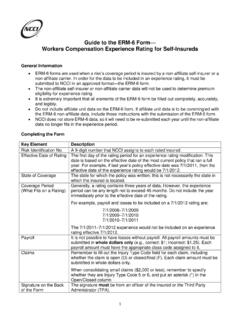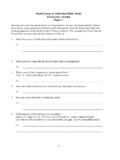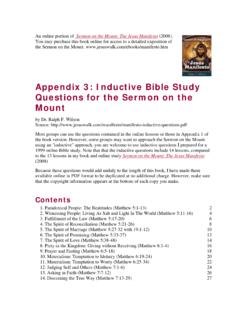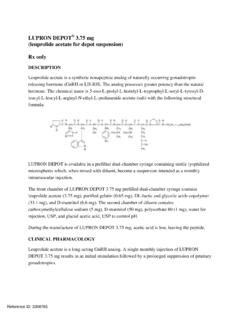Transcription of The Relationship Between Accident Report Lag and Claim ...
1 Workers Compensation2015 Issues Report 42In 2000, a study by The Hartford,using its own data, found that theaverage cost of a workers com-pensation Claim generally rose asthe delay in reporting the Claim in-creased. Effectively managing a workers compensation Claim ensures that the injured workerreceives their benefits efficiently. But an insurer cannot begin to manage a Claim until notice isgiven that an injury has occurred. In this study we look at the Relationship Between Report lag and Claim cost using recent industrywide Findings The median cost of claims reported Between one day and twoweeks after an Accident is significantly lower than the mediancost of claims reported either on the day of the Accident (Day 0) or more than two weeks after the Accident .
2 The Hartford study found that injuries reported in Week 2 hada higher median cost than claims reported in Week 1. NCCI found a slightly different Relationship , which depends on thenature of the injury. For sprains and strains and for contusions,the minimum median cost is for claims reported in Week 1. Forfractures and lacerations, the minimum median cost is forclaims reported in Week 2. Across three-day and seven-day waiting period states, themedian Claim cost for claims reported in Weeks 1 and 2 islower than the median Claim cost for claims reported on eitherthe day of the Accident or more than two weeks after the Relationship BetweenAccidentReport Lag and Claim Cost in Workers Compensation InsuranceBy Thomas SheppardActuarial Consultant NCCI Data DescriptionThis study uses NCCI's Detailed Claim Information dataCall (DCI), which includes data for 44 states.
3 Reporting requirements for DCI were revised for claims reported to insurers beginning in September of 2009. This paper is the first use of this new version of DCI for NCCI is used for this research because it is the only sourceavailable to us that includes the date the Claim was re-ported to the insurer. DCI also includes more Claim detailthan other available data are required to Report all Fatal and Permanent Totalclaims in the DCI Call. Claims where only medical benefitsare provided are not reported. Because certain informationrequired in the DCI data Call is sometimes not captured incompany claims systems, carriers are required to submitonly a sample of other claims.
4 For each state, NCCI speci-fies two sampling ratios one for open claims and one forclosed claims. To determine which claims to Report underDCI, carriers select a random sample of their open andclosed claims as of 18 months after Report date, using thesampling Claim Cost:We define Claim cost as the case incurredamount reported in DCI. This amount includes lost-timebenefits paid, medical costs paid, vocational rehabilita-tion expenses, and the case reserve. It reflects the insur-ance carrier s best estimate of the amount required tosettle the Claim . Claim cost does not include loss adjust-ment expense.
5 Report Lag: Report lag is the number of days betweenthe date an Accident occurs ( Accident date) and thedate the insurer receives notice of the Accident (reportdate). For example, if an Accident occurs on January 15and the insurer receives notice of the Claim on January18, this Claim will have a Report lag of three days. Simi-larly, a Claim reported on the day of the injury has a lagof zero days. Both the Accident date and the Report dateare reported in DCI. Jurisdiction State:The jurisdiction state of a Claim is thestate whose statutes determine the benefits to be pro-vided to the injured worker.
6 This could be the same statewhere the injured worker usually works (the exposurestate) or the state where the worker was injured (the acci-dent state). Lost-Time Claims:We refer to claims that include indem-nity amounts as lost-time claims because indemnity ben-efits are associated with time away from work. Onlylost-time claims are reported in study considers lost-time claims with two excluded occupational disease and cumulative injuryclaims because the Accident date for such claims is de-fined differently from that for a traumatic injury. The cost ofa workers compensation Claim is related to how soon aworker returns to work and whether they have resulting dis-abilities that limit their earnings.
7 Therefore, we excludedFatal and Permanent Total claims since these workers donot return to used data from Report Years 2010 and 2011. Thesewere the most recent complete years available at the timeof the study . Although Report Year 2010 was available valued at 30 months after the Report date, we used bothyears valued as of 18 months to have the data at a com-mon maturity. The one exception to this is the comparisonof Report Year 2010 at 18 and 30 months to determinewhether Claim maturity affects the results. Data for claimsreported to insurers before September 2009 was not avail-able in the current DCI use the DCI sample database to describe the total pop-ulation of workers compensation traumatic injury claims, weapplied a weight to each Claim based on the sampling ra-tios.
8 The sampling ratio is defined in the DCI reporting re-quirements and varies by injury type, Claim status, andjurisdiction state. In general, the weight is the inverse of thesampling ratio. For example, if the sampling ratio for openclaims in State A is 50%, then each open Claim in State Areceives a weight of 2. We also applied a factor to adjustfor any carrier-specific departures from the prescribedsampling ratios. We calculated weighted median Claim costs for claims re-ported (1) the day of the Accident , (2) in each of the firstfour weeks after the Accident , and (3) after the fourth selected the median as our measure of central ten-dency because it is less influenced by extreme values thanthe an effort to find drivers of the differences in median costsby Report lag, we split the data into various categories asnoted below and illustrated in the next section.
9 Overall Claim costs Distribution of claims Percentage of claims by nature of injury - Sprains/strains- Fractures- Contusions- LacerationsWorkers Compensation2015 Issues Report 43 Waiting period Share of medical Percentage with attorney involvement Percentage with lump-sum payments Closure ratio Paid-to-incurred ratiosNote that while we are able to identify correlations in thedata, we are not able to determine cause-and-effect rela-tionships. In particular, we cannot necessarily concludethat for two similar injuries, with one reported early and theother reported late, late reported Claim will cost more than the early reported Claim , fact of late reporting will cause the cost of the sec-ond Claim to be higher than it would have been had itbeen reported earlierDetailed ResultsOverall Claim CostsThe median cost per Claim for claims reported on the dayof the injury is about 25% more than the median cost forclaims reported in Week 1, as shown in Exhibit 1.
10 Claimsreported on the day of the injury likely include very severeinjuries that require immediate medical attention. Suchclaims often require extensive medical care and an ex-tended recovery time away from found that median cost was lowest for claims reportedin Weeks 1 and 2. Median Claim cost rises for claims re-ported in Week 3 by about 35% relative to Week 2. In Week4, the median cost rises another 12%. Median Claim costdrops a bit for claims reported after Week 4 but is stillhigher than for those reported in Weeks 1 and 2 shows that more than 80% of lost-time claims arereported within the first two investigated several different subcategories of claimsto determine whether this pattern of Claim cost variation byreport lag was consistent across of InjuryWe looked at claims by the nature of injury for some of themost common natures of injury.














